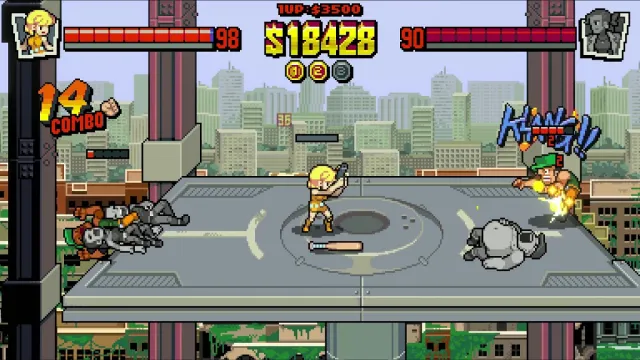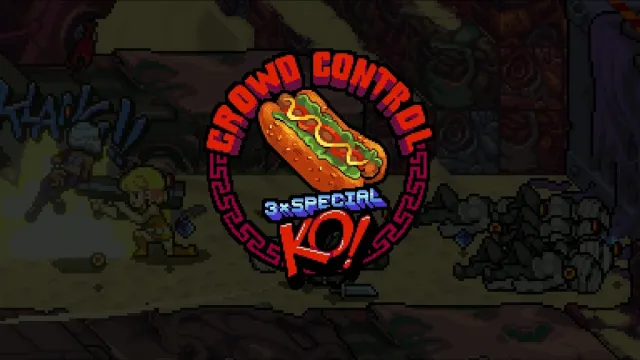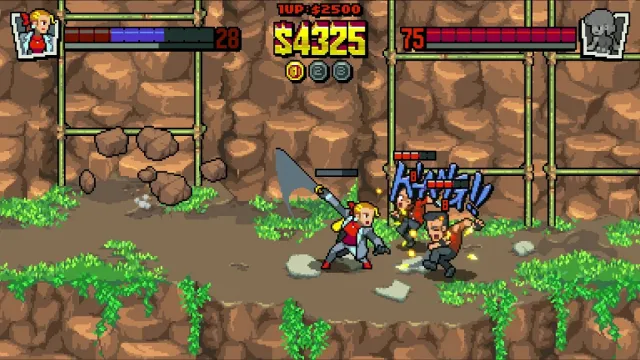Review: Double Dragon Gaiden: Rise of the Dragons
Initially released in 1987, Double Dragon is one of the most important belt-scrolling brawlers in the history of the genre. While it wasn’t the first, and most of its mechanics were accomplished previously by Technos’ own Renegade in 1986, Double Dragon’s popularity both in arcades and through its home ports established the success of the formula. It has been cemented in the annals of game history (or however that saying is supposed to go).
Because of this, the series has never really died, even after the original developers, Technos, went bust. However, since 1995, it’s largely been remakes…or worse. In 2012, there was WayForward’s excellent Double Dragon Neon, but that kind of stands apart from lesser attempts to revive the series.
Now, we have Double Dragon Gaiden: Rise of the Dragons, which is a fresh attempt by Secret Base, the creators of Streets of Red. Is it time for this duo of dragons to actually rise?

Double Dragon Gaiden: Rise of the Dragons (PC [Reviewed], PS4, PS5, Xbox One, Xbox Series X|S, Switch)
Developer: Secret Base
Publisher: Modus Games, Joystick
Released: July 27, 2023
MSRP: $24.99
Our heroes, “Bimmy” and Jimmy, are training in their post-apocalyptic dojo in the rotting remains of New York City when they get a visit from the mayor. He’s got Marian, who may or may not still be Bimmy’s boyfriend and who might or might not have died previously. I’m not sure if Double Dragon Gaiden is a prequel or a new continuity. I’m not sure that’s important.
What is important is where it takes its influence from, and it’s a similarly confusing situation. I’m tempted to say that Double Dragon Gaiden is a one-button brawler, but it’s a little more nuanced than that. You technically have your default attack button, the “action” button, and the special button, which all do attacks. However, the special button requires you to build up a gauge (which generally happens quickly), and the action button is about as useful as a can opener on a jar.
With every character I’d try, they would invariably dash or roll past the enemies in front of them and then swipe at the air. The air was never impressed. To make use of the action button, you must have a really solid feel of where your character is going to land after their dash. Even if you do manage to get this technique down, the action button is far less useful than just landing a combo or special attack.
Sousetsuken
The combat system in general irks me. There is no real grapple mechanic, and jump attacks aren’t particularly useful, either. You’re mostly whittled down to spamming your combo and special attacks. To be fair, the enemies are brilliantly animated, and the combat at least has a sense of impact behind it, but that only goes so far. That luster is important to the genre, but it wears off quickly.
That’s not to say there’s no strategy present here, but a lot of it boils down to making good use of special attacks. As I said previously, your special gauge refills quickly, and there are things you can do to expedite it further. A lot of your success is to know how to make the best use of your characters’ three special attacks and pull them off constantly.
It technically works. Double Dragon Gaiden escapes the threshold of being a bare minimum brawler, but it also pales in comparison to some of the games that have been pushing the beat-’em-up towards a new standard. Compared to games like Fight’N Rage, Streets of Rage 4, and even the comparatively mundane Teenage Mutant Ninja Turtles: Shredders Revenge, Double Dragon Gaiden doesn’t stack up.
To make matters worse, it feels terrible on an arcade stick. It’s all that action button’s fault. That and the fact that the run is bound to a button and can’t be executed by double-pressing a direction. At least you can rebind buttons, which wasn’t an option on an earlier build I played.

Dragon scales
I feel like most of the effort in Double Dragon Gaiden was spent on the art. It’s funny, because when the game was announced, the gripe I heard people echo the most was that they didn’t like the art style. I love it! It’s colorful, clean, and well-animated. But whether you think it’s appealing or not, it’s the place where the love of the property is most evident.
The aesthetic is supported by the sound design. The music is decent, but the way that Double Dragon Gaiden screams at you in support of what a good job you’re doing is key. It feels very arcade-y, and adds to the impactfulness of the combat. On that note, I do think it’s kind of strange that there is no CRT filter option, but I might be one of the few people who care about that sort of thing.
And for as lacking as the combat is, you at least get some variety from all the characters. Beyond Jimmy, Bimmy, Marian, and Uncle Matin, you can also unlock all the bosses and sub-bosses. This means that, yes, you can play as Abobo. The single-player portion of the game also utilizes a tag system, which means that you’ll always have double dragons that you can swap between. You can only trade out when your special gauge is full, and there aren’t really any tag combo opportunities, but, at the very least, it works as a decent life system. When your main fight-person goes down, you have your second choice to back you up.

Thanks, tips
One of the more unique mechanics that Double Dragon Gaiden implements is its progression system. There are four stages to select from at the beginning, and they change in length depending on the order you complete them. Your first choice is always going to be the shortest and easiest, with each one following growing harder and longer as you proceed (there’s an obvious dick joke there, but I’m not reaching for it). Beyond adding some much-needed replay value, it’s a great way of allowing you to personalize your journey. Got a boss you hate? Take them on first to make sure they’re out of your way.
On the other hand, there’s a lot of focus on gaining money that you exchange at the end of each run for tokens. These tokens can be used in a store to buy various things. You might think this would add a roguelite element where you buff your favorite characters between runs, but it totally isn’t. You have four types of things you can buy: characters, hints, art, and music. I only found value in one of those things. I’m not the type to listen to music or view art within a game, and the hints are things you probably already know or could figure out in a single playthrough. It’s things like “prioritize this dude first” or “try to group enemies together so you don’t get overwhelmed.” C’mon, guy. This isn’t my first rodeo.
I think that sort of outlines what a small production Double Dragon Gaiden is. It doesn’t really feel like it’s trying to be revolutionary in any way, nor does it seem like it wants to present you with a glut of content. It serves more as a tribute to the Double Dragon series but more in an aesthetic sense, as the combat system is unlike any of the previous games. You can tell that a lot of love went into making the game, but that doesn’t necessarily result in something indisposable or memorable.
It’s less a rise and more of a bow.
[This review is based on a retail build of the game provided by the publisher.]
For all the latest Gaming News Click Here
For the latest news and updates, follow us on Google News.

